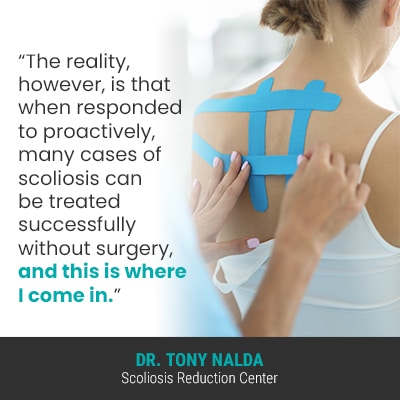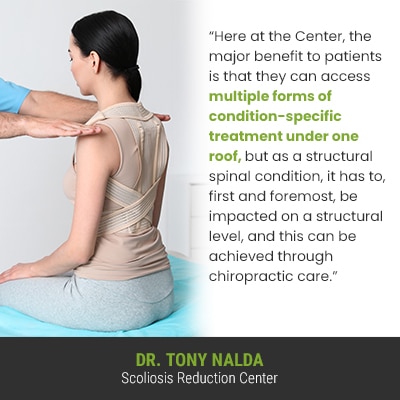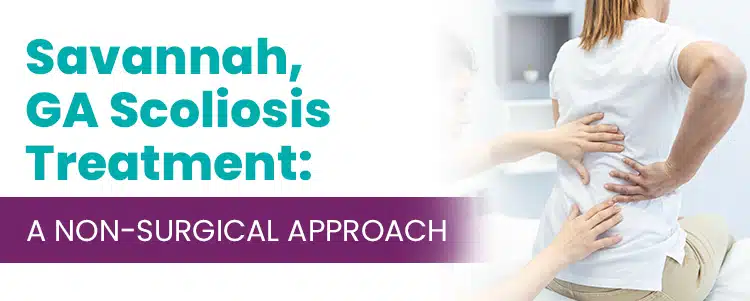Once a diagnosis of scoliosis is given, the most important decision to make is how to treat it, and this is because there is no one-size-fits-all treatment plan; the complex nature of scoliosis necessitates a specialized and customized treatment approach, and different scoliosis treatment approaches offer patients different potential outcomes.
For those in search of Savannah, Georgia scoliosis treatment, scoliosis chiropractor, Dr. Tony Nalda, is a mere 5-hour drive, or a one-hour flight away in Celebration, Orlando; people travel great distances to experience the type of results the Scoliosis Reduction Center® has become known for.
As a complex spinal condition, there are certain parameters that have to be met in order to reach a diagnosis of scoliosis, so let’s start by defining the condition and explaining how it’s diagnosed.
Understanding Scoliosis
A healthy spine is curved at each of its main spinal sections, and these curves make the spine more flexible, stronger, and better able to absorb/distribute mechanical stress incurred during activity.
There are a number of spinal conditions that involve a loss of one or more of the spine’s natural curves, and scoliosis, as the leading spinal condition amongst school-aged children, is highly prevalent.
Scoliosis is the development of an unnatural sideways spinal curve, and a scoliotic curve also rotates, making it a 3-dimensional spinal condition.
The unnatural spinal curve also has to be of a minimum size to be considered a true scoliosis: Cobb angle measurement of at least 10 degrees.
When the spine’s natural curves are in place, its vertebrae (bones of the spine) are aligned in a straight and neutral position as they should be, but when an unnatural spinal curve develops, one or more vertebral bodies are unnaturally tilted and are misaligned with the rest of the spine.
A spine that’s not aligned is a spine that’s not going to be as strong, flexible, or function optimally.
Scoliosis is a Progressive Condition
In addition, as a progressive condition, scoliosis has it in its nature to get worse over time, especially if left untreated, which is why how a diagnosis is responded to is so important.
There are two main scoliosis treatment approaches, traditional and conservative; while the former tends to funnel patients towards invasive spinal fusion surgery, the latter values a proactive response by working towards preventing progression and the need for surgery.
Fortunately, for those in the Savannah, Georgia area, the Scoliosis Reduction Center® has been helping thousands thrive with scoliosis for over 20 years, and is only 260 miles away in the Celebration, Orlando area.
So now that we’ve defined scoliosis and explained how it’s diagnosed, let’s move on to how it can be responded to with treatment, and the different potential results that patients have to choose between.
Scoliosis Treatment Options
Although as a progressive condition, scoliosis is incurable, it is highly treatable, and depending on the type of treatment chosen, patients can experience different potential results that can affect quality of life.
Scoliosis progressing means the unnatural spinal curve is increasing in size, which makes it more rigid, and less responsive to treatment.
In addition, scoliosis also affects the muscles surrounding the spine, so the more a scoliosis is left to progress, the more likely a related muscle imbalance developing is going to be an issue.
While there are never treatment guarantees, early detection and intervention does increase the likelihood of treatment success, but again, that depends on the type of treatment approach applied.
The traditional treatment approach is more reactive than proactive, so let’s explore what that means.
Traditional Scoliosis Treatment
Traditional scoliosis treatment commonly funnels patients towards spinal fusion surgery because it doesn’t have a strategy for treating scoliosis while mild, only once it’s severe enough for patients to become surgical candidates.
So a diagnosis of mild scoliosis, for those on the path of traditional scoliosis treatment, is commonly met with the recommendation to watch and wait, meaning observing the condition for further signs of progression; to me, this is wasting valuable treatment time because as a progressive condition, we know it’s going to get worse at some point, so why not work proactively to prevent it, rather than wait for it to happen?
Scoliosis ranges widely in severity from mild to moderate and severe to very severe, and this is the condition’s progressive line.
If a patient progresses into the severe classification with a curvature degree of 40+ degrees, and shows signs of continued progression, patients are commonly presented with spinal fusion surgery as the best remaining treatment option.

The reality, however, is that when responded to proactively, many cases of scoliosis can be treated successfully without surgery, and this is where Dr. Tony comes in.
Conservative Scoliosis Reduction Center® Treatment
Here at the Scoliosis Reduction Center®, our results speak for themselves.
When a diagnosis of mild scoliosis is given, I explain to the patient that while they might be feeling anything but fortunate, the fact that a diagnosis was reached early in the condition’s progressive line means there are fewer limits to what can be achieved.
I value being proactive, meaning treatment is started as close to the time of diagnosis as possible, and this is because scoliosis is simpler to treat while mild, when the spine is going to be its most responsive.
So while traditional scoliosis treatment values watching and waiting and responding reactively, conservative scoliosis treatment wants to impact the condition on every level, while working towards preventing progression.
It’s far simpler to work towards preventing increasing condition severity, and its effects, than it is to try and reverse those effects once they’ve developed.

Here at the Center, the major benefit to patients is that they can access multiple forms of condition-specific treatment under one roof, but as a structural spinal condition, it has to, first and foremost, be impacted on a structural level, and this can be achieved through chiropractic care.
Chiropractic Care
Chiropractic treatment of scoliosis involves a series of techniques and manual adjustments.
I want to work towards repositioning the most-tilted vertebrae, at the apex of the curve, back into alignment with the rest of the spine; this reduces the curvature size on a structural level, while also reducing the condition’s uneven forces, and their effects.
Once I see the type of structural results necessary in significant curvature reductions, I can shift the focus to increasing core strength.
It’s not just the spine that’s responsible for maintaining its natural curves and alignment, but also its surrounding muscles.
Scoliosis doesn’t just affect the spine, but also its surrounding ligaments, nerves, and muscles.
So physical therapy and condition-specific exercises and stretches can work towards strengthening the muscles the spine relies on for support and stabilization.
As scoliosis progresses, the unnaturally-curved spine is pulling the muscles in different directions, and this can cause them to become strained, sore, stiff, and unbalanced.
Physical therapy can help ensure the spine is optimally supported and correct any related muscle imbalances that have developed.
Corrective Bracing
While no brace on its own can correct a scoliosis, corrective bracing can be particularly effective on growing spines and can help augment corrective results achieved by other forms of treatment by pushing the spine into a corrective position.
Here at the Center, I favor the ScoliBrace for its ultra-corrective potential.
Rehabilitation
If a significant curvature has been achieved and the spine’s alignment has been improved, once the spine’s surrounding muscles have been strengthened, I want to further stabilize the spine for long-term sustainable treatment results.
Through a series of custom-prescribed scoliosis-specific exercises (SSEs), I can help patients establish a home-rehabilitation program to hold the curve reduction and maintain optimal muscle strength.
Conclusion
So those in the Savannah, Georgia area can benefit from Dr. Tony’s non-surgical treatment approach, only 260 miles away in the Celebration, Orlanda area, while others have great distances to traverse to access his industry-leading Scoliosis Reduction Center®.
If you, or someone you care about, has been recently diagnosed with scoliosis, don’t lose hope; many of my patients still thrive with their condition and can lead extraordinary lives, despite being diagnosed with a progressive spinal condition.
Don’t hesitate to reach out here for guidance and support that can greatly improve a patient’s quality of life.




